Tholpavakoothu
Tholpavakoothuis a form of shadow puppetry that is practiced in Kerala, India. It is performed using leather puppets as a ritual dedicated to Bhadrakali and is performed in Devi temples in specially built theatres called koothumadams.[1] This art form is especially popular in the Palakkad, Thrissur and Malappuram districts of Kerala.[2]
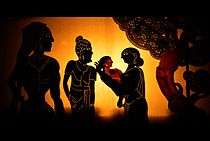
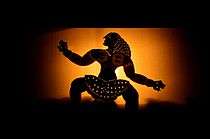
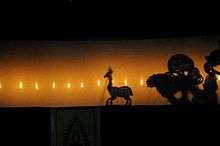
History

Tholpavakoothu is a compound word of three Malayalam terms, thol, meaning leather, pava, meaning doll, and koothu, meaning the play.[2] It is believed to have originated in the ninth century AD and uses Kamba Ramayana as its basic text. The performance language uses Tamil, Sanskrit and Malayalam words. Like Mudiyettu and Patayani, Tholpavakoothu is also an art form that is dedicated to Bhadrakali. According to legend, Tholpavakoothu was performed at the request of Bhadrakali who could not witness Ravana's killing as she was fighting the demon Darika. Thus when it is performed in temples, an idol of the Goddess is usually placed on a pedestal in front of the arena where it is staged.[3][4]
Performances
A koothumadam is a separate 42-foot-long stage on which Tholpavakoothu is performed. The stage has a screen, a piece of white cloth, behind which the puppets are held. The lighting is provided by 21 lamps lit in coconut halves or earthen lamps placed behind the puppets, causing their shadows to fall on the screen. The lamps are a placed equidistantly on a specially constructed wooden beam called a vilakku madam. The performance is accompanied by the recitation of slokas and the performers are required to learn over 3000 of these before they perform. The recitation is accompanied by instruments such as chenda, maddalam, ezhupara, ilathalam, conch and cherukuzhal.[5][6][7]
A full Tholpavakoothu performance, staging all the episodes of the Kamba Ramayana, takes 21 days to complete with nine-hour performances every day, and requires 180 to 200 puppets. A full performance needs up to 40 artistes. The lead puppeteer is called a pulavar. Traditionally, performances begin at night and go on till dawn. The show begins with a kelikottu and an invocation called kalarichinthu.[4] Performances are done from January through May and during poorams. A Tholpavakoothu performance can last 7, 14, 21, 41 or 71 days depending on the tradition at the temple where it is performed. It continues to be performed in over a hundred temples across Kerala.[8]
Puppets
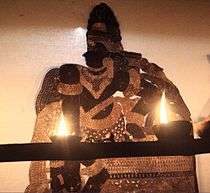
The puppets used in Tholpavakoothu used to be made out of deerskin but are now typically made from goatskin. The puppets are painted in vegetable dyes, as these dyes last long. Some puppets can be as tall as four feet. The puppets are controlled using two sticks; the puppeteer holds the puppet in one hand while its limbs are manipulated using a thinner stick held in the puppeteer's other hand.[2][7]
Puppeteers
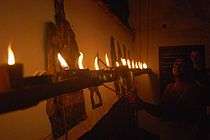
The lead puppeteer is usually a pulavar which is an honorific given to a puppeteer who is also a scholar. Pulavars undergo intensive training in puppetry and have a deep knowledge of Malayalam, Tamil and Sanskrit. Puppeteers have to study the Kamba Ramayana and be well read in the vedas and puranas, Ayurveda, and be trained in classical music. However, some puppeteers forgo classical music as it entails several years of study to master. It can take anywhere from 6 to 10 years of rigorous training for a puppeteer to fully master this art and be able to perform it.[3][5] Ramachandra pulavr and his team shoranur palakkad kerala-09846534998 09539636134
Threats and new trends
Tholpavakoothu, like many traditional art forms, has been facing the threat of extinction due to the arrival of alternate platforms of entertainment such as television and cinema and due to changing cultural values. The younger generation have increasingly failed to take up this art form as it is highly demanding and does not pay much. The audience for these shows have dwindled even in rural Kerala. To cope up with these social changes, the duration of many performances have been drastically reduced. Thematically, puppeteers have begun to introduce contemporary and secular themes to appeal to the youth. Themes such as ragging, communal amity and stories from India's freedom struggle have been featured in recent years. Performances are no longer confined only to temples but are also held in secular venues such as colleges and at the International Film Festival of Kerala.[6][9][10][11]
References
- ↑ "Play of light and shadows". The Hindu. July 13, 2007. Retrieved 4 December 2012.
- 1 2 3 "Tholpavakoothu". Retrieved 4 December 2012.
- 1 2 "Reviving the ancient art of puppetry". The Hindu. November 14, 2009. Retrieved 4 December 2012.
- 1 2 "Enchanting Tholpavakoothu". The Hindu. September 5, 2008. Retrieved 4 December 2012.krishnan kutty pulavar memoria ltholpavakoothu and puppet centre , shoranur, pallakkad, 9846534998,9539636134
- 1 2 "Fading away into the shadows". The Hindu. June 14, 2012. Retrieved 4 December 2012.
- 1 2 "Colourful tales from shadow puppets". The Hindu. March 15, 2011. Retrieved 4 December 2012.
- 1 2 "Tolpava Koothu - The Shadow Puppet Theatre of Kerala". Retrieved 4 December 2012.
- ↑ "Shadow of the original". The Hindu. October 3, 2008. Retrieved 4 December 2012.
- ↑ "Puppet show". The Hindu. Retrieved 4 December 2012.
- ↑ "Shadow of death over Tholpavakoothu". The Hindu. June 23, 2003. Retrieved 4 December 2012.
- ↑ "Shadow leather puppet play facing near death". The Hindu. May 12, 2010. Retrieved 4 December 2012.
External links
| Wikimedia Commons has media related to Tholpavakoothu. |
- puppetry.org.in Tolpava Koothu - Homepage in memory of late Guru Krishnan Kutty Pulavar
- Tholpava Koothu - The Shadow Puppet Play of Kerala,India
- Tholpavakoothu - A unique shadow puppet play
- kutty pulavar memorial tholpavakoothu and puppet centre shoranur
- Tholpavakoothu - Detailes